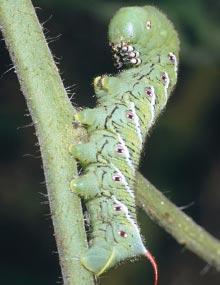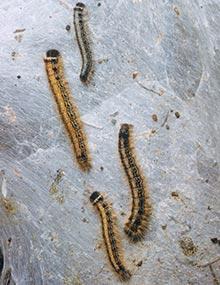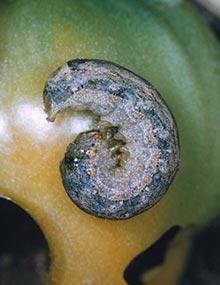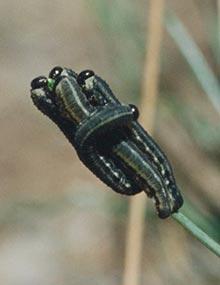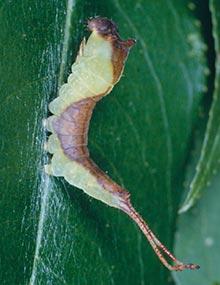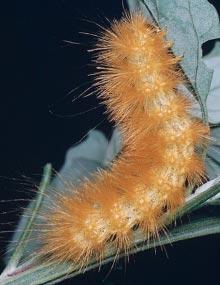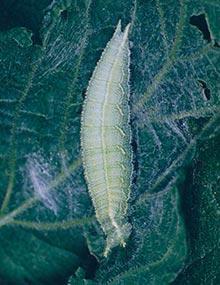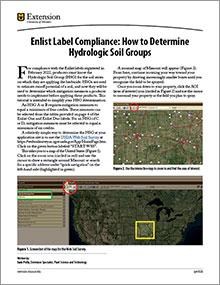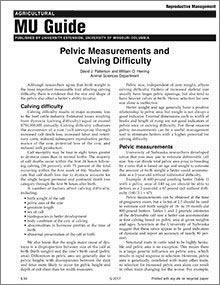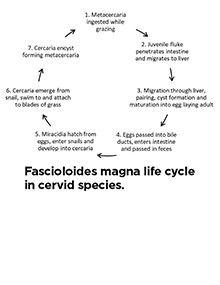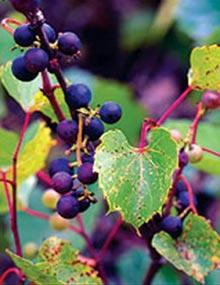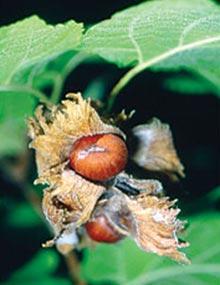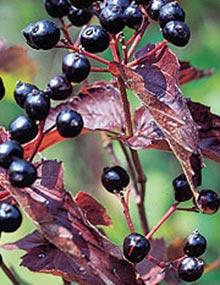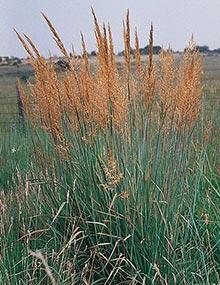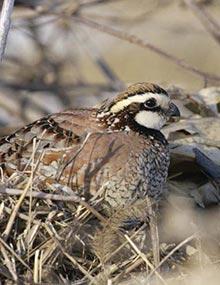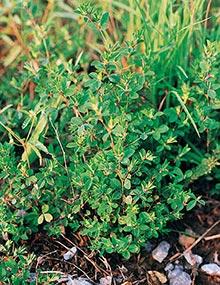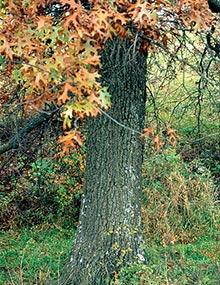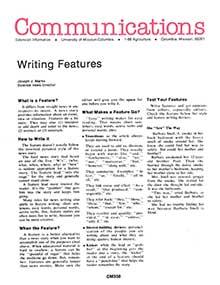Caterpillars in Your Yard and Garden, Page 10
Reviewed
Clearwinged sphinx caterpillars (Hemaris diffinis) are present from April to September. They produce two generations per year.
Caterpillars in Your Yard and Garden, Page 45
Reviewed
Tobacco hornworm caterpillars (Manduca sexta), left, and tomato hornworm caterpillars (Manduca quinquemaculata), below, are present from June through September. They produce two or more generations per year.
Caterpillars in Your Yard and Garden, Page 13
Reviewed
Eastern tent caterpillars (Malacosoma americanum) are present from early spring to June. They produce one generation per year.
Caterpillars in Your Yard and Garden, Page 48
Reviewed
Variegated cutworm caterpillars (Peridroma saucia) are present from late spring to early summer. They produce two to four generations per year.
Caterpillars in Your Yard and Garden, Page 16
Reviewed
European pine sawfly caterpillars (Neodiprion sertifer) are present in spring and summer. They produce one generation per year.
Caterpillars in Your Yard and Garden, Page 51
Reviewed
Red phase and black phase walnut caterpillars (Datana integerrima) are present from early May to September. They produce one to two generations per year.
Caterpillars in Your Yard and Garden, Page 19
Reviewed
Gray furcula caterpillars (Furcula cinerea) are present from spring to fall. They produce two generations per year.
Caterpillars in Your Yard and Garden, Page 54
Reviewed
Yellow woollybear caterpillars (Spilosoma virginica) are present from spring to fall. They produce two to three generations per year.
Caterpillars in Your Yard and Garden, Page 22
Reviewed
Hackberry emperor caterpillars (Asterocampa celtis) are present from early summer to fall. They produce two generations per year.
Reducing Losses When Feeding Hay to Beef Cattle
Reviewed
Feeding hay to cattle is expensive, mostly due to waste. Learn good management practices to minimize the losses that occur due to poor storage methods, improper feeding methods, or both.
Enlist Label Compliance: How to Determine Hydrologic Soil Groups
New
Learn how to use the USDA Web Soil Survey interactive map to determine your field's hydrologic soil group for the soil series on which you plan to apply an Enlist herbicide.
Missouri Farm Labor Guide
Revised
Learn good human resource practices related to employee recruitment, hiring, onboarding, training and termination that your farm or agribusiness can use.
Pelvic Measurements and Calving Difficulty
Reviewed
Although researchers agree that birth weight is the most important measurable trait affecting calving difficulty, there is evidence that the size and shape of the pelvis also affect a heifer’s ability to calve.
Liver Flukes in Missouri: Distribution, Impact on Cattle, Control and Treatment
Reviewed
Cattle operations should evaluate their risk for is Fascioloides magna, also known as the deer fluke or the giant liver fluke. Learn about its distribution in Missouri, its life cycle, treatment and more in this guide.
Quail-Friendly Plants of the Midwest, Page 21
Reviewed
Wild grapes are vines capable of climbing to 75 feet or more by means of tendrils. Leaves are alternate, simple and heart-shaped (Vitis) to triangular (Ampelopsis). Flowers bloom from mid to late spring, and globe-shaped fruits are borne in drooping clusters from late summer through fall.
Quail-Friendly Plants of the Midwest, Page 53
Reviewed
Three-seeded mercury is characterized by longitudinally folded, lobed, leaflike bracts that persist throughout the growing season. The seeds are small, egg-shaped and dark brown to light gray or tan.
Quail-Friendly Plants of the Midwest, Page 24
Reviewed
Hazelnut is a thicket-forming, spreading shrub that can vary in height from 3 to 10 feet. Its leaves are egg-shaped to oval, doubly serrated with five to eight veins on each side of the central vein. Fruits occur in clusters of two to six.
Quail-Friendly Plants of the Midwest, Page 56
Reviewed
Viburnum grows as shrubs or small trees with branching crowns. Flowers are borne in dense, flat-topped panicles that produce many red to bluish black, berrylike fruits in fall. The leaves are opposite and turn brilliant shades of deep rose-purple to rose-red or bright red in fall.
Quail-Friendly Plants of the Midwest, Page 27
Reviewed
Indian grass is a tall, warm-season nativethat averages 4 to 6 feet in height at maturity. Stems are stiff, and leaves are long and narrow. A characteristic of the plant is the notched ligule, suggesting the rear sight of a rifle.
Quail-Friendly Plants of the Midwest, Page 59
Reviewed
Acknowledgments
The authors gratefully acknowledge the following individuals and groups for their constructive review of this publication: Steve Clubine, Elsa Gallagher, Emily Horner, Lee Hughes, Aaron Jeffries, Matt Seek, Tim Smith, Bill White, and members of the Missouri Quail and Grassland Bird Technical Committee.
Quail-Friendly Plants of the Midwest, Page 30
Reviewed
Annual lespedeza and Korean lespedeza exhibit many similarities in growth form, occurring as semierect herbaceous plants with three-lobed leaves and reddish-purple to white flowers. Lower leaves are spreading while upper leaves stand erect.
Quail-Friendly Plants of the Midwest, Page 33
Reviewed
Oaks are long-lived trees that produce a seasonally important food for dozens of wildlife species. Their distinctive leaves and bark are identifying features.
Writing Features
Reviewed
Good feature writers are imaginative, curious, nosey, attentive, unconventional, witty, and usually are not above "borrowing" a good writing idea from someone else.
Quail-Friendly Plants of the Midwest, Page 36
Reviewed
More than three dozen species of panic grass are commonly found across the Midwest. Seeds are football-shaped and borne on a sprawling, panicle-shaped seed head. The leaves of panic grasses resemble flags along the stem.

